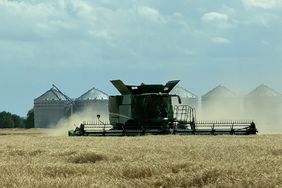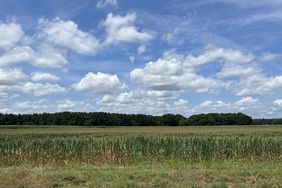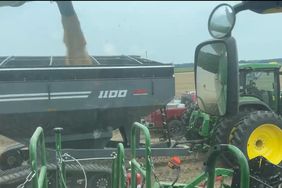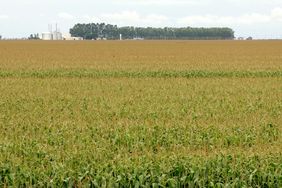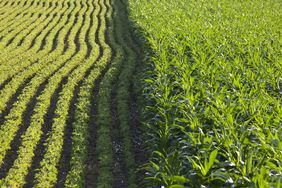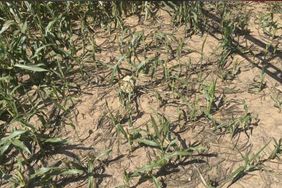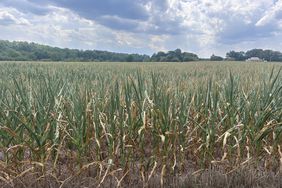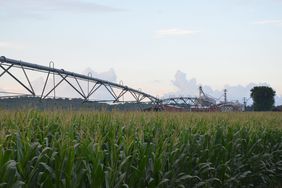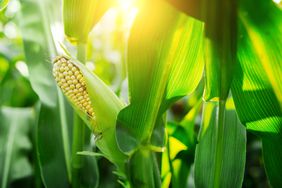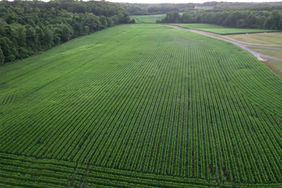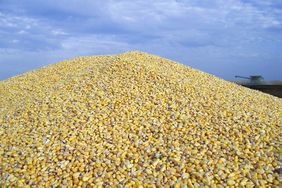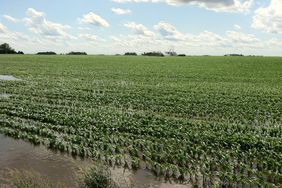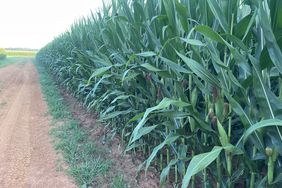:max_bytes(150000):strip_icc()/CH20Dry20Corn-2000-51d255f6b21c464fa647e30c5becc9f6.jpg)
XtremeAg
XtremeAg farmers Chad Henderson, Kelly Garrett, and Lee Lubbers report on the latest crop conditions from their farms across the country.
Chad Henderson - Madison, Alabama
Chad Henderson is a fifth-generation farmer in Madison, Alabama. Henderson Farms includes over 8,000 acres of dryland and irrigated corn, dryland soybeans, wheat, and dryland and irrigated double-crop soybeans. When not farming, Chad can be found carrying on another proud family tradition as a drag racer for Henderson Racing.
Alabama corn
The irrigated corn is green and healthy and is looking good. We’ve had a lot of heat the last two weeks, so we're having to keep all the pivots going as much as possible. Unfortunately, you know, irrigation systems are irrigation systems. Some of them run really well, and some of them, need some long-term repairs on them. We're not used to having to run them for three weeks straight. They're just not made to run like that.
The non-irrigated corn, according to plant date, looks pretty rough. Maybe we'll make a half a crop. We just made a fungicide application on our brown tassel and for brown silk on our irrigated corn.
Alabama soybeans
The early soybeans that we have that are not irrigated, if we have another dry week, they won't be worth harvesting. It's very dry right now, but we've gotten a shower or two of rain in places, so some soybeans will be average. It's just according to where we got rain. It's been so hot and dry for the last two weeks that it's really taken a toll on the crop.
:max_bytes(150000):strip_icc()/Chad-Henderson-soybeans-IMG_5650-73d07f864f4748ebb7175e10498f93f6.jpg)
XtremeAg
The irrigated soybeans look pretty good where we can keep water to them, so we made a fungicide application again on those.
Our double crop soybeans are up and growing. We got them planted in the moisture, so we got a stand of soybeans, which was huge.
Kelly Garrett - Arion, Iowa
Kelly Garrett is a fifth-generation farmer in western Iowa. Garrett farms 4,000 acres of corn, over 1,800 acres of soybeans, and 170 acres of winter wheat.
Iowa row crops
It continues to rain. We had some nice rains last week, rain today, and rain tomorrow. Of course, I feel bad for the people in northwest Iowa, southwest Minnesota, southeast South Dakota, where all the flooding is occurring. My thoughts go out to them with all of the damage that they're sustaining.
:max_bytes(150000):strip_icc()/IMG_9882-f048db0ea1a74938a4932fa4d3675755.jpeg)
XtremeAg
Our crop looks pretty decent. Some of my corn in the thinner areas. It looks a little uneven, so I have some concern about that. Not sure if it's nitrogen or wet weather or a combination of both, but overall, the crop looks really good.
Rotational grazing
Our pastures look great. With my rotational grazing project, we will turn the cows out on the warm season mix next week. I keep saying it, but what a difference a year makes! From hot and dry to really nice temperatures. We have had really nice temperatures and terrific rainfall so far.
Last week I went to Southeast Arkansas for the first time to Matt's field day. They had a great turnout! Then, my wife Amber and I stayed with Matt and his wife Sherrie Kay for a couple of days to learn more about farming in the Delta. It is a lot different than it is in west central Iowa. It's very hot and it's very flat. Those are my two biggest takeaways. Overall, it was a great trip down there and getting to meet new people and seeing their different way of life 700 miles south of Iowa.
Lee Lubbers - Gregory, South Dakota
Lee Lubbers is a fourth-generation farmer in Gregory, South Dakota. Lubbers Farms includes more than 17,000 acres of dryland soybeans, corn, and wheat. Lubbers says he is always trying to learn and challenge himself.
South Dakota weather
Summer keeps on moving along. We finished up planting, and afterwards, very large rains hit the area. We are lucky compared to places east and southeast of us. During one week, we received 5 to 8 inches of rain, with the highest amount being on the southern edge of our farm. If you go even an hour east of us, you can literally double the amounts. We lost a few acres to drown-out spots, yet we feel very fortunate. We have more rolling terrain and have part of our low ground tiled, and both factors were a huge benefit to us in our area.
:max_bytes(150000):strip_icc()/IMG_6685-a9a498cbcdaa40d1881987db0aef3c02.jpeg)
XtremeAg
We just finished moving our last 15,000 bushels of soybeans from the 2023 crop. We don’t have a lot of corn left. We are glad we moved our 2023 bushels when we did this year. We are cleaning and prepping grain bins on cooler days to be ready for the winter wheat harvest.
South Dakota winter wheat
Our wheat crop was ahead of schedule even a month ago. Yet the cooler temperatures and rains over the last few weeks have really slowed down its maturing.
:max_bytes(150000):strip_icc()/Lee-Lubbers-winter-wheat-July-2024-204a2d8b2d8c4d11944279151bc5c40c.jpeg)
XtremeAg
Sometime between July 12 and 15, we feel we will start the harvest push. We have about two weeks of cutting to do if things go well. The custom harvester that runs with us has started moving combines up from Kansas. The army of people and trucks/grain hoppers will be showing up in the second half of next week.
The United States, Canada, and South Africa will all be represented during wheat harvest. Everyone pulls together to make it happen. I call it RED: Redneck Economic Development. We become their unofficial home away from home during the harvest. Every morning, they grab breakfast and supplies uptown. Every lane in the fuel island at the local gas station is full of their trucks. They buy all their groceries locally and become part of our community twice a year. For the better part of three months, they contribute to and are part of our area’s economy. They support numerous local businesses when they are here helping us harvest.
South Dakota soybeans
We are finishing spraying soybean post-chemical and making sure we are ready for the next push right around the corner. Stay safe, everyone.
